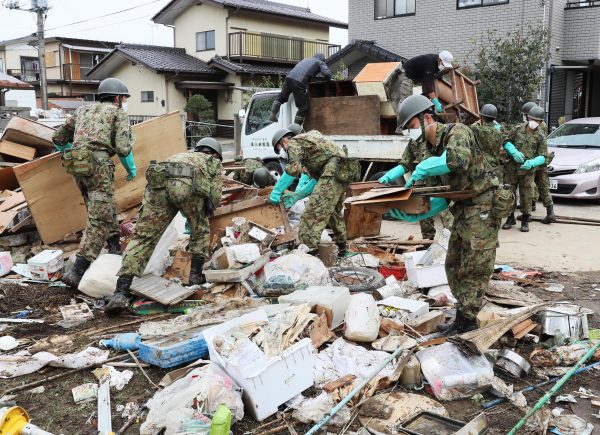The Japan Maritime Self-Defense Force (MSDF) cancelled an international fleet review to focus on disaster relief efforts. The Japan Self-Defense Forces (SDF) are responding to the ongoing crisis by deploying helicopters, boats and thousands of troops to assist local authorities in rescuing civilians and restoring normalcy.
Indian Prime Minister Narendra Modi responded to the typhoon with a condolence message and pledged support to its ‘natural partner’ Japan for disaster relief. The Indian Navy deployed two ships (INS Sahyadri and INS Kiltan) to support Japan’s disaster relief efforts — they were in Japan for a trilateral naval exercise involving the United States, Japan and India.
This is the first time Indian naval ships have been deployed in the Far East of Japan for Humanitarian Assistance and Disaster Relief (HA/DR) operations. The Indian Navy has a decade of experience in providing relief from natural calamities and will certainly benefit Japan. This has significance in the context of increasingly robust India–Japan maritime security cooperation.
The 2004 Indian Ocean Tsunami was a wakeup call for many countries about the regional state of disaster readiness. It catalysed cooperation between India and Japan. When India’s East Coast and Andaman and Nicobar Islands were completely devastated, Japan and Australia were the first partners to respond. India also supported surrounding countries such as Sri Lanka in relief operations while simultaneously managing the disaster within its own borders.
Significantly, India along with the United States, Japan and Australia contributed more than 40,000 troops and humanitarian responders in disaster relief operations in the region in the nine days following the 2004 tsunami. These four major countries acted quickly in creating an ad-hoc coalition known as the ‘Tsunami Core Group’. This was a stepping stone for long-term diplomacy between the four states in the form of an informal strategic group known as the Quadrilateral Security Initiative.
Japan played a substantive role in the relief operation. The deployment of three MSDF naval vessels, helicopters and 1000 troops in the Bay of Bengal and the Indian Ocean was the largest relief operation ever carried out by the SDF. India and Japan coordinating for the first time in the HA/DR operation demonstrated the importance of maritime cooperation for building a strong partnership between two countries. Leaders of both countries have emphasised the importance of non-traditional security challenges in the Indian Ocean, including HA/DR, in all their engagements since 2004.
In 2012, India and Japan conducted their first ever joint maritime exercise (JIMEX) to ‘gauge interoperability’ — the HA/DR operation was highlighted in the press release from the Indian Ministry of Defence. But in the subsequent JIMEX in 2013 and again in 2018, there was no reference to HA/DR in the statements released by the Ministry.
Perhaps, with the changing global landscape, the objective of maritime security cooperation has shifted more towards China’s role in the region, leaving little focus on HA/DR operations. Although geopolitics is important to maritime security, HA/DR should be increasingly prioritised given the state of natural disasters in the region.
In the last 14 months Japan witnessed four major rainfall disasters and Tokyo was hit twice in less than two months. Meteorologist Kazuhisa Tsuboki said that ‘typhoon risks for midlatitude countries such as Japan are definitely escalating’. He added that the ‘frequency of powerful typhoons and heavy rains [will] grow with global warming’. This is a grim reminder that extreme weather conditions are the new norm for disaster-prone countries.
Like Japan, India as a peninsular country is extremely prone to natural calamities that make HA/DR a pressing problem. The naval forces of both nations play an important role in search and rescue operations and in building emergency shelter for those affected by disasters. With the Indian Navy’s capability around HA/DR, particularly in responding quickly to natural calamities, a main objective should be to share HA/DR skills with strategic partners like Japan.
Japan has made significant commitments to capacity building in HA/DR in Southeast Asian countries. It should continue to enhance its cooperation with India on HA/DR. Greater cooperation in disaster management and emergency response is key to the functionality of any maritime force. India and Japan can learn from each other and build a strong coalition against natural disasters in the Indo-Pacific, above and beyond undertaking periodic joint HA/DR exercises.
Focussing on non-military missions like non-combatant evacuation and disaster relief would lay a foundation for greater strategic maritime cooperation. As Professor Geoffrey Till has argued, both India and Japan should strive to achieve proactive HA/DR, where both naval forces are deployable and ready should disaster strike.
Prakash Panneerselvam is Assistant Professor of the International Strategic and Security Studies Programme at the National Institute of Advanced Studies (NIAS), Bengaluru.

